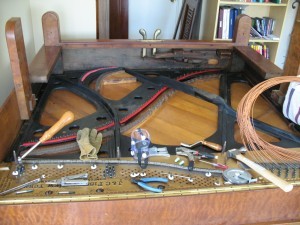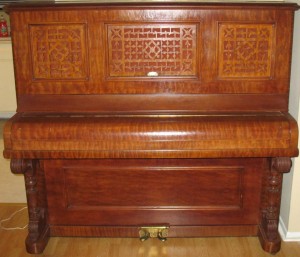Restringing Pianos
Restringing is definitely one of the more challenging repairs one can perform on a piano. What I would like to accomplish in this article is to paint a vivid picture of what is involved in this process, and hopefully allow any piano owners out there make a qualified decision about whether or not to have their own instruments restrung.
A little over a year ago, I purchased an amazing instrument. It was made by J&C Fischer and Sons in ’86. Were you thiking 1986? No, I meant 1886. The exterior of this instrument was in fabulous mint condition. In fact I have never come across an instrument this old in such good health. It was still fully playable. All moving parts were functioning. 99% of everything inside was original. Even though my Pierce Piano Atlas told me the age was around this time (based on the serial number) I still was dubious. It was just too good to be true. However, once when I was taking the entire keybed out so the keys could be refinished, I found several flyers inside for a piano concert dated 1886. Truly remarkable.
J&C Fischer Piano from 1886
Over the course of the next twelve months, I began renovating the instrument. The most major repair by far that I performed was restringing.
Before any restringing could happen, I had to tilt the piano on its back using a special dolly, remove the entire front, not just the panels, and get the old strings off. Because the combined tension of all the strings is over 30,000 lbs, they have to be loosened gradually in several stages. When the strings were loose enough, I cut them off and removed the pins using a drill. All this alone took about a day.

Piano lying flat using “tilter”
Next is where the real magic happens. This is when the new strings are applied. It is typical that when you restring a piano, you put in tuning pins that are larger than the old ones. The reason is that as pianos get older, the pins tend to get loose, meaning the instrument won’t stay in tune. In the case of my piano, the tuning pins were even looser than normal, so I had to put in pins that were a full two sizes larger. That’s to be expected on a piano which is more than 100 years old.

Piano midway through restringing process
The act of putting on a piano string has got to be one of the most physically challenging tasks I have ever attempted. Piano strings are not like guitar strings. That is, they don’t bend easily. They are made of solid steel and are many times thicker in diameter. If you are not totally focused, you will either bend the wire the wrong way and put a permanent crease in it that requires you to discard it. Or, the wire will jump out of your hands and literally fly across the room. This is no laughing matter. When I began the process, I ignored various warnings to where safety goggles. After nearly taking out my eyeballs a few times, I was happy to where them. Piano wire has a mind of its own. Learning to control it takes an incredible degree of sensitivity, focus, assertiveness, and finesse. It typically feels like you are wrestling a large snake and that snake is doing everything it can to overtake you.
Piano with all strings replaced
After repeating this process more than a hundred times over the course of ten days straight, I was finally ready to put the instrument back together. I reinstalled the front of the piano and the legs, and tilted it upright again. It was not time to declare victory yet however. The instrument still had to be tuned.
Tuning a freshly strung instrument is not like tuning a piano for a client. In the same way that detuning all the strings at once can cause problems when removing the strings, the opposite is true as well. Bringing all the strings up to pitch right away can damage the piano so it must be done in multiple passes. What’s more is that as you increase the tension on a few strings, the piano literally shrinks slightly because it is being pulled. What effect does that have? The strings next to it drop in pitch. That means if you went all the way across the piano bringing each string up to pitch and then checked the first string you started on, it would be much flatter than when you started. In the first day, I tuned the piano five times before the strings and the piano had settled in. Over the course of the next few months I probably tuned it another three times before I felt it was fully stable.
With all that work, it is no wonder that restringing a piano generally costs $2000 or more. Technicians who are reasonably experienced can do it in about twenty hours. It is rumored there is a tech in L.A. who can do the entire process in just half a day. In terms of materials, the cost of the plain steel strings and the pegs is probably around $150. However the copper wound bass strings have to be custom made for each piano and this costs several hundred dollars.
If you are considering having your piano restrung, here are the factors you should consider: First, pianos only need to be restrung after decades of use. Unless your piano is quite old, don’t even think about it. The exception would be if the strings are rusty, or if your technician complains the tuning pegs are too loose for it to stay in tune. Most pianos are never restrung. Restringing will cause a slight improvement in tone, but less so than having the hammers reshaped would. In the case of my piano, the improvement in sound quality was nominal. One thing it will not do is turn a mediocre piano into a Steinway.
Second, what is the value of your instrument? If the cost of restringing is more than half the total value of the instrument, don’t do it. Figure a good quality used upright in excellent condition is around $4000. An entry level NEW upright piano is also around $4000. A fair quality used upright is only around $1000 to $2000, don’t go spending $2000 on repairs.
Third, what is the make of the instrument? If you’ve got a 100 year old Steinway, it is OK to put money into it. The reason is that Steinways last forever and also tend to hold their value. Taking measures to maintain the instrument will also help the value. If the piano is a no name brand, sell it and get a newer one before you consider restringing.
When all the factors are considered, its clear that restringing is a repair for special instruments only. It is also clear that when a tech quotes you a price tag of several thousand, he is surely justified in doing so. If you are a technician, I would strongly advise attempting this process yourself. It is a fascinating learning experience.

